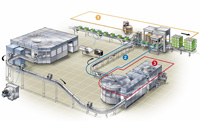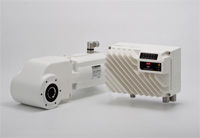The demand for higher energy efficiency, different motor technologies and both centralised and decentralised plant designs has increased the number of solutions in use today for electrical drive components such as motors and frequency converters in many production plants. This leads to large stocks of spare parts, high training costs, dependence on a single manufacturer and a lack of flexibility. Danfoss expects the new flexible VLT® solution for conveyors to make sweeping changes in this area and significantly reduce effort and costs.
In the face of ever increasing competition and growing political and social pressures, producers are constantly looking for new ways to cut costs, reduce energy consumption and improve the environmental compatibility of manufacturing systems.
Electric drive technology is a key technology in this respect. The motor designs used in these drives – whether standard, geared, high efficiency or even in many cases today, permanent magnet (PM) motors – should help to significantly reduce energy consumption. Modern speed control systems in the form of frequency converters also support efforts to optimise plant efficiency and reduce energy costs.
As a result, an overwhelming variety of motor manufacturers and motor types, frequency converters for general and special applications, and solutions for centralised and decentralised plant designs are now available. In addition, many production plants, for example in the food and beverage industry, the chemical industry or the pharmaceutical industry, place special requirements on devices and system components. These may include special protection against detergents and disinfectants for equipment subject to frequent cleaning or high resistance to moisture and contamination to ensure compliance with strict hygiene requirements. In addition, many environments are particularly difficult due to local production conditions, for example in clean rooms or aseptic plant areas.
All this calls for a wide variety of solutions for motors and/or frequency converters. Until now this has forced plant operators to stock a large variety of spare parts, ensure that their maintenance staff is familiar with a variety of control and installation concepts, and provide manufacturer, and/or product-specific, software solutions for configuration and parameterisation. This has led to a significant increase in effort and expense for larger inventories and associated training.
Conveying systems – the lifelines of production plants
Conveying systems in particular, which, as lifelines within the production plant, link the different machines and areas of the plant and run through the different areas, require a large number of solutions tailored to specific requirements. These include dry areas, for example packing or unpacking of containers and goods, wet areas such as bottle washers and sensitive filling areas, which may even require aseptic conditions. Each of these areas requires a specially adapted product, which in many production plants can ultimately lead to thirty or more different components and designs.
What’s more, plant engineers distinguish between centralised and decentralised designs. Both designs have their pros and cons, which must be taken into consideration in the design, development and construction of the plant. Do the devices support sufficient motor cable lengths for centralised installation of all frequency converters in electrical rooms? Do the motors and frequency converters provide adequate protection against detergents and aggressive media in areas where hygiene is important? Do devices for centralised and decentralised use have the same control concept? For example, can the frequency converters control both standard and PM motors, or are different types of device required?
This means that mechanical and plant engineering firms have to provide or adapt a large number of design documents for the different systems and concepts. Depending on their customers’ requirements and corresponding plant concepts, this results in large volume of documentation over time for the systems being used, which needs to be kept constantly up to date and demands a continual learning process. This also makes it more difficult to keep spare parts in stock and requires maintenance and service staff to have extensive expertise.
The same applies to the plant operator. Here too, investment in a large spare parts inventory is required, as well as training for operators and maintenance or service staff.
New approaches are called for to cut these costs by drastically reducing the time, effort and expense involved. However, these solutions should offer both the plant operator and the plant engineering company maximum flexibility to use the latest technologies and increase the energy efficiency of the plant, and, equally important, to reduce maintenance and service costs by cutting staffing levels and shortening service and repair times. This is the only way to further increase the plant availability and to adapt cost-effectiveness to market conditions.

Reducing the overall number of variants by up to 70%
This is precisely where the flexible VLT® solution comes in. It gives plant engineers and operators a very high degree of flexibility in the choice of components and plant structures. Regardless of whether the plant design is centralised or decentralised and whether the drives are used in dry, wet or aseptic areas, the flexible VLT® concept provides highly efficient components for every conveying task.
Danfoss based the development of this solution on its corporate philosophy as a clean-tech company and designed all of the components for optimum energy efficiency. Without exception, the components used in this solution, whether for new plants or for retrofitting or modernising existing plants, are highly efficient and comply with the actual requirements of users and the latest EU regulations on motors and motor efficiency.
The range of components reduces the overall number of variants in the plant by up to 70%. In many cases we are able to provide end-to-end solutions for conveyor applications with just a few variants, so spare parts stocks can be considerably smaller than is currently the case.
Furthermore, the new VLT® concept is currently the only solution on the market offering EHEDG-certified components specifically designed for installation directly in plant areas where hygiene is critical. Some of these components are even IPA certified by the Frauenhofer Institute for use directly in clean rooms. All components are coordinated with each other to ensure rapid commissioning and optimum efficiency of the overall solution.
Thanks to the open system architecture of the VLT® concept, plant operators can easily and reliably combine components with existing solutions from other manufacturers, for example when expanding or refitting the plant, to achieve the required optimum configuration. Using standard components eliminates the need to obtain the complete solution from a single manufacturer and the resulting dependency on a sole source. Nevertheless, Danfoss recommends using optimally compatible components to maximise savings.
The concept aims to optimise costs in tailored drive systems as result of:
· high flexibility;
· high efficiency;
· reducedversioncount;
· an intelligent control concept.

Flexible and energy-efficient – VLT® frequency converters
With the VLT® Decentral Drive FCD 302, for the first time Danfoss is able to offer the same functionality in a decentralised converter as in the VLT® AutomationDrive FC 302, which is designed for centralised plant configurations. Both have the same user interface concept in the form of a graphic message display, which can be connected to the FCD 302 on-the- fly at any time. It shows all operating statuses at a glance. Both device families are also equipped with Safe Torque Off capability. In addition, both devices can drive standard motors with or without encoder feedback, as well as the compact, energy-efficient PM motors in our VLT® OneGearDrive series. They are fitted with suitable line chokes or RFI filters to reduce mains interference.
The VLT® Decentral Drive FCD 302 is available in a standard version in black and white and an EHEDG-certified version in white, which makes it easier to detect dirt deposits. Six LEDs indicate the current device status, even without a display unit. The cooling fins are angled to ensure fast and reliable runoff of cleaning agents and disinfectants.
To simplify device connection in the plant even when a large number of devices are installed, Danfoss has provided the FCD 302 with a T distributor with a large terminal space with EMC dividers. Like the VLT® AutomationDrive FC 302, it is suitable for all TN, TN-S or IT mains configurations. And finally, it has sensor inputs that can also be used as decentralised I/O connectors with Profibus.
The VLT® AutomationDrive FC 302 also supports the use of long motor cables in centralised configurations without the need for additional components. Cold Plate cooling technology enables the use of a simple cooling system and removal of dissipated heat from the electrical cabinet or electrical room as necessary. Its compact design and side-by-side installation capability ensure high power density in the electrical cabinet. Plug-in spring terminals enable easy replacement in the event of failure.

VLT® OneGearDrive – from standard to hygienic design
Danfoss recommends PM motors to achieve optimum energy efficiency. The efficiency of these motors exceeds even the premium IE3 class defined in the new EU regulation. With only two motor types and three available gear ratios, the motor concept covers all typical versions for effective conveyor drives commonly used in the food and beverage industry. It also uses optimised bevel gearing, which is more efficient than commonly used worm gears. The system as a whole, comprising motor, gear unit and frequency converter, achieves an efficiency up to 90%, yielding savings of up to 25% compared with conventional systems.
The VLT® OneGearDrive Hygienic™ is the ideal choice for any application where hygiene is especially important. It has been certified by the Technical University of Munich as EHEDG-compliant and is resistant to cleaning agents in the pH range 2 to 12. Danfoss supplies the VLT® OneGearDrive Hygienic™ with high IP67 and IP69K protection ratings as standard. A proven stainless steel circular plug-and-socket connector simplifies replacement during maintenance. This allows the replacement to be performed by a mechanical service technician alone, without the assistance of an electrician as in the past.
VLT® OneGearDrive Hygienic™ also has a completely smooth, easy to clean surface without cooling fins, which prevents pockets of dirt from forming and allows cleaning agents to drain off freely.
These drives do not have fans, so they do not suck in airborne germs and blast them back into the surrounding air. The drive units are also available with totally encapsulated brakes and/or encoders.
VLT® conveyor solution – Saves you time and money
With the standardised control concept, the common functional scope of frequency converters and easy electrical connection with a stainless steel connector, the OGD Hygienic series reduces both training costs and staffing requirements for maintenance. Furthermore, users remain free to choose their preferred supplier of motors or converter technology unless they decide to rely on the full VLT® conveyor solution package. The resulting substantial reduction in the diversity of spare parts is advantageous, especially in large production plants. In conjunction with short component delivery times, this also yields savings in terms of effort and expense by reducing inventory costs.




Glasgow trial explores AR cues for autonomous road safety
They've ploughed into a few vulnerable road users in the past. Making that less likely will make it spectacularly easy to stop the traffic for...